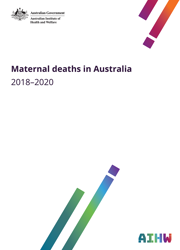Summary
Content warning: This report contains information some readers may find distressing as it relates to maternal deaths, suicide and self-harm, alcohol and drug use, and pregnancy loss.
In Australia, most women have healthy pregnancies. However, while it is rare, sadly some women die during pregnancy or in the postpartum period. All these deaths are reviewed by health professionals to determine the likely cause and whether the pregnancy contributed to the death.
This report focuses on the women who died during pregnancy or within 42 days of the end of pregnancy, regardless of duration, from any cause related to or aggravated by the pregnancy or its management. These are called ‘maternal deaths’. Maternal deaths do not include deaths by accident or other incidental causes.
It is important to understand how often and why maternal deaths happen. Data on maternal deaths can help policymakers and healthcare providers better understand what can be done to ensure mothers stay healthy through pregnancy and beyond.
As maternal deaths are very rare in Australia, this report combines data over a 3-year period (1 January 2018 to 31 December 2020) to allow for more detailed reporting and analysis of maternal characteristics.
The maternal mortality ratio has more than halved since the 1970s
Between 2018 and 2020, about 889,000 women gave birth and there were 63 deaths. Of these, 50 were considered maternal deaths (that is, related to the pregnancy) and 13 were coincidental to the pregnancy. This is a maternal mortality ratio (MMR) of 5.6 deaths per 100,000 women giving birth in 2018–2020 and is the lowest MMR recorded since comparable definitions were introduced in 1973–1975, when the rate was 12.7 per 100,000.
Cardiovascular conditions are one of the leading causes of maternal death
The most common causes of maternal deaths in 2018–2020 were cardiovascular conditions, thromboembolism (blood clots in the veins) and sepsis (8 deaths each).
In 22 of the 50 maternal deaths, factors contributing to the death were identified. The most common factors were grouped as professional care (such as inadequate staffing, failure or delay in emergency response, failure to offer or follow recommended best practice) (12 deaths) and factors relating to the individual, family or social circumstances (for example insufficient or no antenatal care, substance abuse and family violence) (10 deaths).
SARS-COV-2 (COVID-19) infection was not reported as the cause of death for any maternal deaths during 2018-2020.
Some women are at greater risk
The MMR is higher among some groups of women. These include women who:
- have given birth 4 or more times (an MMR of 23.9 per 100,000 women giving birth, or 7 deaths)
- are aged 35 and over (an MMR of 11.7, or 26 deaths)
- smoked in the first 20 weeks of their pregnancy (an MMR of 12.5, or 10 deaths)
- identify as Aboriginal and Torres Strait Islander (an MMR of 9.4, or 4 deaths).
While every death is a tragedy, it is important to remember that maternal deaths are rare, even among these groups. Care should be taken when interpreting these data due to the very small numbers.
The Maternal deaths in Australia series documents 56 years of continuous maternal mortality monitoring in Australia.
If you or someone you know needs help, contact:
- Lifeline on 13 11 14 (lifeline.org.au)
- Griefline on 1300 845 745 (griefline.org.au)
- Perinatal Anxiety and Depression Australia (PANDA) on 1300 726 306 (panda.org.au)
- Suicide Call Back Service on 1300 659 467 (suicidecallbackservice.org.au)
- National Alcohol and Other Drug Hotline on 1800-250-015
- SANDS miscarriage, stillbirth and newborn death support 1300 308 307 (sands.org.au)
Summary
1. Introduction
- What is included in this report?
- What are maternal deaths?
2. Overview of maternal deaths
- Trends in maternal deaths
- Factors influencing maternal death rates .
- State or territory of maternal death
- International perspective
3. Maternal characteristics
- Maternal age at death
- Aboriginal and Torres Strait Islander women
- Remoteness of usual residence
- Socioeconomic area
- Country of birth
- Parity
- Body mass index
- Smoking during pregnancy
4. Clinical characteristics & investigations
- Antenatal care
- Complicating conditions during pregnancy
- Onset of labour
- Birth method
- Timing of maternal death
- Location of death
- Baby outcomes in maternal deaths
- Incidence of autopsy
- Contributing factors in maternal deaths
5. Causes of maternal deaths
- Direct maternal deaths
- Indirect maternal deaths
- Causes of maternal deaths by maternal characteristics
- Causes of death by maternal age
- Causes of death by parity
- Causes of death by Indigenous status
- Causes of coincidental deaths
- Trends in causes of maternal deaths
- Thromboembolism
- Cardiovascular disease
- Sepsis
- Amniotic fluid embolism
- Substance use complications
- Suicide
- Non-obstetric haemorrhage
- Hypertensive disorders
- Obstetric haemorrhage
- Ectopic pregnancy
- Homicide
- Other causes of maternal deaths
Appendix A: Data sources and method
- The National Maternal Mortality Data Collection .
- Advisory groups
- Measuring maternal mortality
- Reporting maternal deaths
- The Australian maternity context
- Identifying Aboriginal and Torres Strait Islander women
- Deaths by suicide
- Remoteness area
- Socioeconomic area
Appendix B: Further reading
End matter: Acknowledgements; Abbreviations; Symbols; Glossary; References; List of tables; List of figures.



